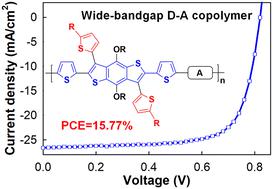当前位置:
X-MOL 学术
›
J. Mater. Chem. A
›
论文详情
Our official English website, www.x-mol.net, welcomes your
feedback! (Note: you will need to create a separate account there.)
Benzodithiophene with multiple side-chains for efficient wide-bandgap D–A copolymers
Journal of Materials Chemistry A ( IF 10.7 ) Pub Date : 2023-01-13 , DOI: 10.1039/d2ta08629h Zhijian Li 1, 2 , Yunlong Ma 2 , Qingdong Zheng 1, 2
Journal of Materials Chemistry A ( IF 10.7 ) Pub Date : 2023-01-13 , DOI: 10.1039/d2ta08629h Zhijian Li 1, 2 , Yunlong Ma 2 , Qingdong Zheng 1, 2
Affiliation

|
The limited selections of wide-bandgap polymer donors have prevented the further increase in the power conversion efficiency (PCE) of organic solar cells. In this work, we report two novel wide-bandgap alternating copolymers (PL4 and PL5), which were synthesized by copolymerizing a new benzodithiophene-derived electron-rich unit (D) with two electron-deficient units (A) of 5,6-difluoro-2-(2-hexyldecyl)-4,7-di(thiophen-2-yl)-2H-benzo[d][1,2,3]triazole and 1,3-bis(2-ethylhexyl)-5,7-di(thiophen-2-yl)-4H,8H-benzo[1,2-c:4,5-c′]dithiophene-4,8-dione, respectively. PL5 shows a broader and red-shifted absorption spectrum compared to PL4 due to the more electron-withdrawing feature of its A moiety. Moreover, the energy levels of PL5 are relatively down-shifted compared to those of PL4. When blended with a low-bandgap non-fullerene acceptor (Y6), the best-performing PL5:Y6-based device exhibits a significantly higher PCE of 15.77% with an enhanced VOC of 0.818 V, an excellent JSC of 26.60 mA cm−2, and a higher fill factor (FF) of 72.47% in comparison with the PL4:Y6-based PSC which shows a PCE of 7.53% with a VOC of 0.718 V, a JSC of 21.60 mA cm−2, and a FF of 48.58%. The improved PCE of the PL5:Y6-based device can be ascribed to its more efficient charge transfer, dramatically increased charge carrier mobilities and reduced charge recombination.
中文翻译:

具有多个侧链的苯并二噻吩用于高效宽带隙 D-A 共聚物
宽带隙聚合物供体的有限选择阻碍了有机太阳能电池功率转换效率(PCE)的进一步提高。在这项工作中,我们报告了两种新型宽带隙交替共聚物(PL4 和 PL5),它们是通过将一种新的苯并二噻吩衍生的富电子单元 (D) 与两个 5,6- 缺电子单元 (A) 共聚合合成的二氟-2-(2-己基癸基)-4,7-二(噻吩-2-基)-2 H-苯并[ d ][1,2,3]三唑和1,3-双(2-乙基己基)- 5,7-二(噻吩-2-基)-4 H ,8 H -苯并[1,2- c :4,5- c']dithiophene-4,8-dione,分别。与 PL4 相比,PL5 显示出更宽且红移的吸收光谱,这是因为其 A 部分具有更多的吸电子特性。此外,与 PL4 相比,PL5 的能级相对较低。当与低带隙非富勒烯受体 (Y6) 混合时,性能最好的基于 PL5:Y6 的器件表现出 15.77% 的显着更高的 PCE,增强的V OC为 0.818 V,出色的J SC为 26.60 mA cm −2,与基于 PL4:Y6 的 PSC 相比,填充因子 (FF) 更高,为 72.47%,后者显示出 7.53% 的 PCE,V OC为 0.718 V,J SC为 21.60 mA cm -2, FF 为 48.58%。基于 PL5:Y6 的设备的改进 PCE 可归因于其更有效的电荷转移、显着增加的电荷载流子迁移率和减少的电荷复合。
更新日期:2023-01-14
中文翻译:

具有多个侧链的苯并二噻吩用于高效宽带隙 D-A 共聚物
宽带隙聚合物供体的有限选择阻碍了有机太阳能电池功率转换效率(PCE)的进一步提高。在这项工作中,我们报告了两种新型宽带隙交替共聚物(PL4 和 PL5),它们是通过将一种新的苯并二噻吩衍生的富电子单元 (D) 与两个 5,6- 缺电子单元 (A) 共聚合合成的二氟-2-(2-己基癸基)-4,7-二(噻吩-2-基)-2 H-苯并[ d ][1,2,3]三唑和1,3-双(2-乙基己基)- 5,7-二(噻吩-2-基)-4 H ,8 H -苯并[1,2- c :4,5- c']dithiophene-4,8-dione,分别。与 PL4 相比,PL5 显示出更宽且红移的吸收光谱,这是因为其 A 部分具有更多的吸电子特性。此外,与 PL4 相比,PL5 的能级相对较低。当与低带隙非富勒烯受体 (Y6) 混合时,性能最好的基于 PL5:Y6 的器件表现出 15.77% 的显着更高的 PCE,增强的V OC为 0.818 V,出色的J SC为 26.60 mA cm −2,与基于 PL4:Y6 的 PSC 相比,填充因子 (FF) 更高,为 72.47%,后者显示出 7.53% 的 PCE,V OC为 0.718 V,J SC为 21.60 mA cm -2, FF 为 48.58%。基于 PL5:Y6 的设备的改进 PCE 可归因于其更有效的电荷转移、显着增加的电荷载流子迁移率和减少的电荷复合。




















































 京公网安备 11010802027423号
京公网安备 11010802027423号